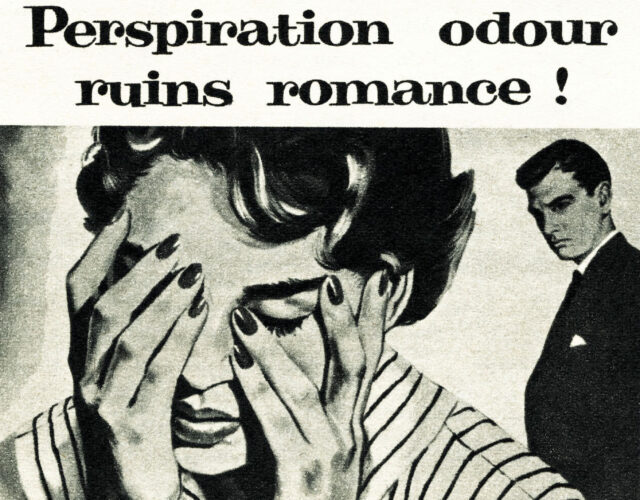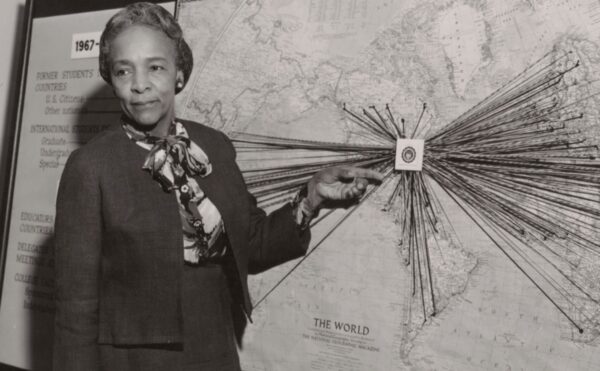For as long as humans have been around, they’ve worried about their smell. “That’s why we’ve had perfumes for as long as we’ve had people,” says Cari Casteel, a CHF research fellow studying the history of deodorant. But, Casteel says, “it wasn’t until the late 19th, early 20th century that the technology and the chemistry catches up to what people want.”
Today most Americans don’t give a second thought to using deodorant. In fact, some 90% of the population slathers the stuff on. But in the late 19th and early 20th centuries, deodorants and antiperspirants were new, and their makers had to convince potential customers (all women) that perfumes alone weren’t cutting it and that their body odor and perspiration were unacceptable. They did so by preying on women’s insecurities; an approach later used successfully on men.
In this episode, we explore some of the funny, disturbing, sexist, and quirky advertisements from deodorant’s history and discover that today’s commercials are strangely similar to those of the past.
Credits
Hosts: Michal Meyer and Bob Kenworthy
Guest: Cari Casteel
Producer: Mariel Carr
Associate Producer: Rigoberto Hernandez
Additional Production by Kyrie Greenberg
Music courtesy of the Audio Network
Transcript
ACT 1 Intro
Secret commercial >> You are a bear. You dominate. You’re brilliant, articulate. Yes, those numbers are correct. Yes, those projections are faceable. Cause you’re killing it.
Michal: Hello and welcome to Distillations. I am Michal Meyer, a historian of science and editor in Chief for Distillations magazine here at the Chemical Heritage Foundation.
Bob: And I’m Bob Kenworthy, CHF’s in-house chemist.
Michal: That was a 2017 commercial for Secret deodorant. Two women in an elevator are psyching themselves up to pitch a business plan. One has her hands up, and she’s pretending to be a bear, while the other woman gives her a pep talk. The text at the end reads: “major pressure moments need major sweat protection.”
Bob: The ad is silly. But it’s inspiring. And the message is clear: women can be confident and powerful. As long as they use Secret deodorant, of course.
Michal: For almost as long as there’s been deodorant, there have been deodorant advertisements. And they tell us a lot about the history of deodorant and how we think about gender. Let’s go back to the beginning of it all, to an early deodorant ad that caused quite a stir.
ACT 2 Odorono ad
Sarah R. Odorono print ad>> A woman’s arm! Poets have sung of its grace; artists have painted its beauty.
Michal: This is the opening line of a 1919 ad that first appeared in the magazine called Ladies Home Journal.
Bob: Odor?
Michal: Oh, no!
Bob: The ad takes up a whole page. At the top there’s a small picture of a woman and a man in evening wear, embracing on a terrace. But, like many ads in those days, the rest of the page is text! It looks like a magazine article. And it goes on at length about a woman’s arm.
Sarah R. Odorono print ad>>It should be the daintiest, sweetest thing in the world. And yet, unfortunately, it isn’t, always.
Michal: The ad explains that in order to be perfectly dainty—and appealing to men of course— women must make sure they don’t perspire or smell. There was a lot at stake. A woman didn’t just risk being stinky, but being stinky and alone. And if it isn’t apparent from this ad, in deodorant’s early days the product was marketed exclusively to women. Men, it seems, were free to be smelly.
Bob: The ad used a popular tactic of the day. It was known as ‘scare copy’.
Sarah R. Odorono Print Ad>> For it is a physiological fact that person’s trouble with perspiration odor seldom can detect it themselves.
Jean Retzinger >> What it is, essentially, is this attempt to make us anxious about our own bodies and the idea that our bodies can betray us, and they can betray us in ways that we are going to be unconscious of.
Michal: That’s Jean Retzinger. She’s a Media Studies professor at the University of California, Berkeley and she uses this ad in her course about the history of advertising. She uses the phrase “psychological warfare” to describe it.
Jean Retzinger >> This kind of sense of really distancing you from your own body and asking you not to even trust your own perceptions, to trust your own relationship with your body. That your body, again, is going to betray you every opportunity it has. That’s one of the things that’s going on, just to set up this anxiety in the part of the consumer.
And you know, this sort of distancing, this kind of unease within the world, unease about ourselves.
Michal: When that ad appeared in 1919 deodorant was still relatively new and brands like Odorono didn’t just have to convince consumers they needed their brand, they had to convince them they needed it at all. That they stank.
Bob: Even though deodorant was still a relatively new product, people have been trying to make themselves smell like something other than humans forever.
Act 3 The history and science of deodorant
Cari Casteel >> People have always worried about how they smelled. That’s why we’ve had perfumes for as long as we’ve had people.
Bob: That’s Cari Casteel. She’s a research fellow here at CHF and she is studying the history of deodorant.
Michal: In the Victorian era more people than ever before were living close together in cities. The Victorians were hyper-aware of offending others, but they wouldn’t talk about it.
Cari Casteel >> Definitely you weren’t sitting down with your girlfriends for tea, and talking about someone else who smells like onions. You were also discouraged from things like sneezing in public. You needed to hide any sorts of strange bodily functions that would make you stand out.
Bob: So all these people were living closer to one another, trying to smell nice and proper, and perfume just wasn’t cutting it.
Cari Casteel >> What happens in the late 19th, early 20th century is that the technology and the chemistry catches up to what people want.
Michal: Perfume just masked bad odors. Deodorant though, went after the root cause of the odor altogether. And that’s just what the first kind did in the 1880s. It was called Mum and it was actually made just down the street from CHF. Right here in Philly. It was a cream mostly made up of perfume and zinc oxide, which kills odor-causing bacteria. But smell wasn’t the only problem plaguing Victorian women.
Cari Casteel >> You’re not even supposed to sneeze in public, so sweating in public would also be a faux pas for you as a woman.
Michal: Even with a deodorant like Mum, Victorian women still had to hide the fact that they perspired. One way of covering it up was by wearing dress shields that provided a barrier between the underarm and the dress. They worked well enough, but they weren’t very comfortable. But when Odorono came along it went beyond odor control. It stopped sweat altogether. It was the first antiperspirant.
Cari Casteel >> It was a different kind of product which a lot of women really wanted. In fact, one of the early advertisements for Odorono says, “Odorono makes dress shields unnecessary.”
Michal: Unfortunately there would be a price to pay for the convenience of not sweating. But we’ll get to that in a minute. But first, Bob, we’re actually talking about two different things here, right? Deodorant and antiperspirant. You’re the scientist, tell us what the difference is.
Bob: So starting with deodorant. It’s important to know that sweat, as it’s generated in the skin is odorless. And the stink doesn’t come about until the sweat interacts with environmental bacteria on the skin and the sweat starts to ferment. And it’s the fermentation products that stinks, not the sweat itself. So the best way to control that process is to kill the bacteria so that they don’t work on the sweat and cause it to ferment. But you’re still left with a wet skin when you sweat. And that’s why antiperspirants came in to actually physically block the sweat gland pores. So the liquid itself would never get to the surface of the skin.
Michal: Thanks for the chemistry lesson Bob. Now I want to get back to how Odorono came to be. It’s a pretty interesting story.
Michal: Knowing what we now know about deodorants early users, it shouldn’t be that surprising that the first antiperspirant was made by a teenage girl — with some help from her father. Edna Murphey, a high school student from Cincinnati, brought antiperspirant to the masses.
Cari Casteel >>So the story really starts with Abraham Murphey, Edna’s father. He was a surgeon and is having trouble operating on his patients because his hands are profusely sweaty, and so he works to come up with a preparation that will stop his hands from sweating so much so that he can actually hold the tools and more effectively do his job.
Bob: He made an aluminum chloride solution. Aluminum chloride constricts and plugs the sweat glands pores, so it would make you perspire less.
Cari Casteel >>Edna decided to try it on her underarms where she was experiencing profuse sweating. And when it seemed to work, she went and started talking to her friends, and was like this is great. You should all try this,
Michal: They liked it too.
Cari Casteel >> It was, I think, 1912 when she buys a little booth in Atlantic City and starts hocking this new product that she has named “Odor, Oh No!” and sales were decent, not super phenomenal, but she made enough money that she was able to buy a storefront and a separate place to start producing Odorono. And so from there, I guess, it just started exploding.
Bob: Odorono really worked, but there was a tradeoff. The solution was anywhere from 25-40% aluminum chloride. It really irritated the skin and burned through clothing.
Cari Casteel >> There were some complaints about Odorono being very strong and painful. But it didn’t really stop women from using it. I mean, some women did stop using it, but it didn’t stop a lot of women from using it because some said they know it’s working because it burns, right? You know that it must be working because of the sting, and some women said they would rather buy new clothes than to deal with perspiration odor. So it was a really important product for some people who didn’t want to be embarrassed by their odor.
Act 4 Old ads vs. new ads
Michal: So despite the pain it inflicted, Odorono became a success. Women were that concerned about being sweaty and stinky. Business was going great, which brings us back to that Odorono ad. Edna Murphey made Odorono’s early ads by herself. But eventually she had enough money to hire a big New York City firm called J. Walter Thompson.
Cari Casteel >> The fact that they were able to hire a larger ad firm was like, “hello, we’re here. We have a large enough company that a national marketing scheme makes sense.”
Bob: And that’s who made the “Within the Curve of a Woman’s Arm” ad.
Michal: The scare tactics weren’t new, nor was the message that without deodorant women would never catch a man. This is the copy from a 1888 Mum ad:
Mum’s 1888 >>
MEN DO TALK about girls behind their back – although they won’t admit it. Is a girl pretty, a good sport, a smooth dancer? The answer quickly goes the rounds!
They talk about other thing, too. About the girls they hate to dance with – the girls they simply won’t take out. For a girl must be more than pretty and smart. She’ll never make a hit with men unless she is truly sweet – nice to be near.
Unpopularity often begins with the first hint of underarm odor.
Bob: As time went on deodorant and antiperspirant companies realized that they were missing half the market by only marketing to women. It was still much more acceptable for men to be sweaty, and even stinky. Although, some men were already closet deodorant users.
Cari Casteel >> But it was still very hard to encourage men to go to a store and pick a deodorant up and take it to the checkout and buy a deodorant. It took companies completely making a wholly separate masculine type of deodorant for men to slowly begin coming out of the deodorant closet and buying their own deodorant.
Bob: So how did they do it? First they made the packaging look “manly.” One kind of deodorant came in a black bottle. Another brand was shaped like a whiskey jug. Even as late as the 1950s men still needed to be convinced that deodorant was not just for women.
Stopette deodorant commercial from 1953.
Michal: And ads for men’s deodorant began praying on their insecurities, like performing on the job. Take this
Dan>> Wait don’t tell me a big he-man like you uses a deodorant.
Locker room >> Not a deodorant, Dan. It’s Stopette spray deodorant and there’s nothing sissy about it.
Dan>> Ah, go on
Locker room man>> Listen, it isn’t only heat that makes us perspire. Excitement will do it too. Pressure of business, any kind of tension.
Dan>> Yeah but does it really work on men?
Locker room man>> You’re doggone right it does.
Bob: It’s a funny twist: remember that Secret commercial with the two women in the elevator? Here’s another one from that series of the same two women getting ready to pitch their business plan.
Secret Commercial:
Woman 1: Solid, strong. Uh, ow, too much.
Woman 2: yeah, Sorry.
Woman 1: Site visits?
Woman 2: 1.2 million.
Women 1: Conversion?
Woman 2: 6.4 percent.
Women 1: I doubt you girls can pull that off.
Woman 2: I got the data right here sir.
Woman 1: Who came up with this business plan?
Bob: It’s all about performing on the job. And now, some of today’s men’s deodorant ads are all about sex appeal. This is a clip from an Axe commercial.
Axe commercial >> Mom: Welcome home.
Son: Mom, Dad, this is Cindy
Dad: Cindy, yes.
Cindy: So nice to meet both of you.
Mom: It’s nice to meet you too.
Dad: Travis has told us so much about you.
Cindy: All good things, I hope.
Bob: A young man brings his girlfriend home to meet his parents, only to reveal that he has several girlfriends. A whole parade of them in fact. They apparently can’t resist the scent of his Axe body spray.
Travis: Oh, Oh. Mom, Dad. This is Shannon
Mom: Oh.
Dad: Shannon? Travis: And this is Erin. Erin: Hi cutie.
Travis: That is Jessica, Shannon, Sarah, Meghan, Nicole, Elizabeth,
Narrator: Axe, Use in moderation.
Cari Casteel >> Deodorants specifically that are marketed to young men are using eerily similar advertising tactics to what Odorono was doing in 1920. So if you watch any advertisement for Axe, for instance, it’s all about men’s relationship to the opposite sex. If
you put this on, women won’t be able to stop themselves from coming after you, that wearing this deodorant makes you more attractive and women will like you. That’s the same thing that Odorono was saying in their advertisements – wearing this deodorant will make men like you and you’ll be more attractive and otherwise they won’t.
Michal: Nowadays the main target for deodorant is no longer women –or adult men — but teenage boys, and increasingly teenage boys of color.
Bob: And Cari Casteel has some ideas about this trend.
Cari Casteel >> Everyone says wearing deodorant makes you feel confident, and so especially in minority groups, confidence is really important [00:12:00] to making them feel like a part of a society that they’re sort of an outlier.
Michal: Distillations is more than a great podcast. We’re also a multimedia magazine.
Bob: You can find our videos, our blog, and our print stories at Distillations.org
Michal: We’re a bunch of very nice people. And none of us stink. For Distillations, I’m Michal Meyer.
Bob: And I’m Bob Kenworthy.
Michal and Bob: Thanks for listening.




